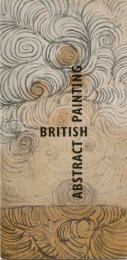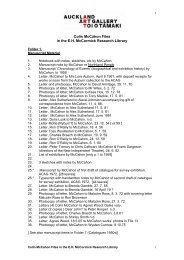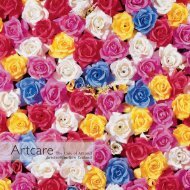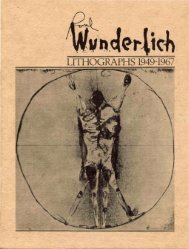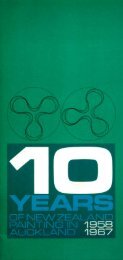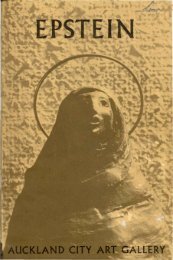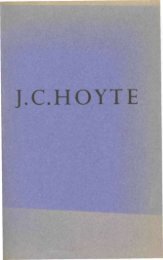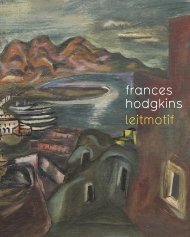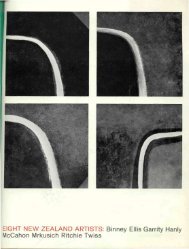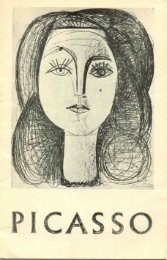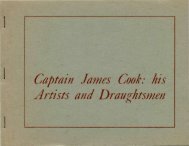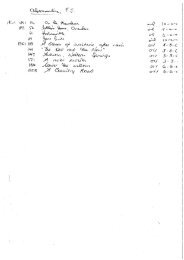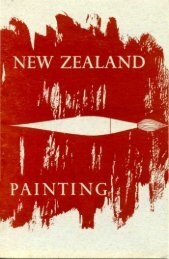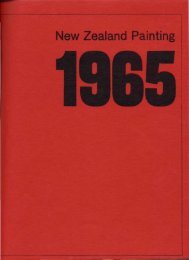GEORGE COOK (after Parkinson) - Auckland Art Gallery
GEORGE COOK (after Parkinson) - Auckland Art Gallery
GEORGE COOK (after Parkinson) - Auckland Art Gallery
Create successful ePaper yourself
Turn your PDF publications into a flip-book with our unique Google optimized e-Paper software.
<strong>GEORGE</strong> <strong>COOK</strong> (<strong>after</strong> <strong>Parkinson</strong>)
AUCKLAND CITY ART GALLERY<br />
QUARTERLY<br />
EDITORIAL<br />
This issue is devoted to early New Zealand.<br />
Over the past few years this part of the collection<br />
has been augmented quite considerably;<br />
and most recently by Hodges' Dusky Bay. If<br />
the main emphasis may lie in the historical<br />
importance of these works, many are by artists<br />
who approached their task of documentation<br />
with sensitivity and a sympathetic eye, giving<br />
us today paintings or drawings which are still<br />
valid for their perceptive images of this country<br />
and its people.<br />
<strong>GEORGE</strong> <strong>COOK</strong>E (1781-1834) British<br />
PERFORATED ROCK WITH A PA, TOLAGA, NEW<br />
ZEALAND (COVER)<br />
Line Engraving (coloured) 136 x 200mm<br />
This print by George Cooke, who was a well<br />
known reproductive engraver, is taken from another<br />
engraving which appeared in Hawkcsworth's<br />
Voyages, 1773. Both are derived from<br />
a pencil drawing (B.M. Add. M.S. 23920.46)<br />
by H. D. Sporing, assistant naturalist on<br />
Cook's first voyage to the Pacific. The drawing<br />
and earlier print arc reproduced, Smith,<br />
European Vision and the South Pacific, Nos.<br />
15, 12. Our print, published 1812, probably<br />
was made for Pinkerton's Collection of Voyages<br />
and Travels (17 Vols., 1808-14). However,<br />
the curious error has occurred (not mentioned<br />
by Dr Smith) that Sporing's drawing<br />
is of a similar rock with a fortified pa in Mercury<br />
Bay (ibid: p.18). Thus Hawkesworth's<br />
engraver made the initial error of confusing the<br />
two rocks — to be followed, no doubt, by many<br />
others. One may assume that the drawing by<br />
page two<br />
NUMBER TWENTY —1962<br />
<strong>Parkinson</strong> (botanical artist, First Voyage)<br />
from the landward side of the Tolaga rock<br />
(Smith No. 14) has been confused with the<br />
reverse of the Mercury Bay one. This topographical<br />
error, however, does not diminish<br />
Dr Smith's interesting observation that these<br />
two natural grottoes had some influence on<br />
the formation of English Romantic taste in<br />
nature.<br />
WILLIAM HODGES RA (1744-1797) British<br />
A VIEW IN DUSKY BAY, NEW ZEALAND<br />
Oil on panel 647mm diameter<br />
Purchased with the aid of the National <strong>Art</strong><br />
Collections Fund, 1961. This attractive painting<br />
is probably one of the repetitions by Hodges<br />
from those of his paintings of the South Seas<br />
painted for the Admiralty. This is the only<br />
roundel by Hodges known to us, and the fact<br />
that it is on a half inch thick mahogany panel<br />
might indicate that it was adapted from some<br />
shipboard use. However, the highly finished<br />
painting would argue against the conjecture<br />
that it might have been done on the spot.<br />
Hodges was draughtsman to Cook's second<br />
voyage (1772-1775), visiting New Zealand in<br />
1773, while the figure of the Maori is taken<br />
from his Waterfall in Dusky Bay (53 x 75i —<br />
Admiralty). The landscape background docs<br />
not appear in any of the other Dusky Bay<br />
scenes which he painted.<br />
Cook describes in his journal (12 April<br />
1773) the occasion of meeting the Maori<br />
family of whom Hodges made numerous drawings<br />
— and by whom he was given the name<br />
of Taitoe.
Hodges here combines the scientific demand<br />
for topographic and botanic description<br />
and the idea of ' the noble savage' which suffused<br />
18th Century attitudes towards the Pacific.<br />
Two other illustrations of, presumably, the<br />
same family arc in the collection — both are<br />
engravings <strong>after</strong> Hodges, the last being dated<br />
1777 —and one which he certainly supervised<br />
as it is similar in spirit to the Maori in the<br />
painting. The other engraving, however, renders<br />
the family as a classical group, to conform<br />
with contemporary neo-classical opinion which<br />
found it hard to accept romantic realities. The<br />
ability of the Nineteenth Century reproductive<br />
engraver to erect and maintain myths can<br />
not be underrated.<br />
Hodges, apart from his Pacific voyage,<br />
painted in India and was probably the most<br />
widely travelled artist of his time. Disappointment<br />
in his career made him take up banking,<br />
at which he failed shortly before his death.<br />
page three
JOSEPH JENNER MERRETT (1816-1854) New<br />
Zealand<br />
PORTRAIT OF A MAORI GIRL CALLED EONO (LEFT)<br />
Watercolour 191 x 140mm<br />
Presented by Captain D. Rough<br />
PATUONE (RIGHT)<br />
Watercolour 280 x 219mm<br />
Presented by Captain D. Rough<br />
Writing of Merrett's Maori Feast at Remuera<br />
1844, T. M. Hocken remarks that' the artist of<br />
this primitive watercolour was Joseph Merrett,<br />
a former resident of New South Wales and an<br />
interpreter . . . latterly he lived near Gisborne<br />
and died at Wellington in 1854.' From the<br />
time of his arrival in 1839 until some time<br />
<strong>after</strong> 1847 Merett lived in <strong>Auckland</strong> and as<br />
well as his sojourn near Gisborne mentioned<br />
by Hocken he is listed as a resident of New<br />
Plymouth in 1852.<br />
In 1844 the New Zealander stated that Mr<br />
Merrett ' intends to resume his former profession<br />
of land surveyor;' in 1846 (11 April) the<br />
same paper advertised his ' lithographs of various<br />
Maoris.' It appears that Merrett travelled<br />
page four<br />
to Sydney in 1844 and again in 1846 from<br />
where the New Zealander (1 August 1846) reports<br />
on Merrett propounding a Utopian<br />
scheme to constitute Heke ' a sort of Pacificator-General<br />
of the Maori's.' In 1847 Merrett<br />
under the pseudonym of ' Crayon ' contributed<br />
original verse to the New Zealander and also<br />
the text of his 'The Lizard Rock, a New Zealand<br />
ballad: written and illustrated by Merrett,<br />
dedicated to Governor Grey and to be<br />
published in England.'<br />
Later in 1847 Merrett advertised as ' Portrait<br />
and Landscape painter to His Excellency the<br />
Governor, Studio in Chancery Street, in Mr<br />
Coolahan's new house at the back of the Exchange<br />
Hotel.' Merrett's painting of Maori's<br />
illustrate A. S. Thomson's The Story of New<br />
Zealand (1859) and Vol. 5 of Augustus<br />
Hamilton's Maori <strong>Art</strong> (1900).<br />
PATUONE died on 19 September, 1872. He<br />
was a link with the earliest history of New<br />
Zealand being one of the Ngapuhi natives<br />
who saw Captain Cook's ship the Endeavour<br />
at Cape Brett (November 1769).
LOUIS DE SAINSON (F). Mid 19th C.) French<br />
VIEW OF WHANGAREI HARBOUR<br />
Hand coloured lithograph 206 x 3-12<br />
Purchased 1961<br />
This hand-coloured lithograph has been titled,<br />
on the stone, Vue du Cap Wangari. De Sainson<br />
(born 1801), a special clerk in the Admiralty<br />
at Rochefort, was taken on by Dumont<br />
D'Urville in the capacity of an artist for the<br />
earlier voyage of the Astrolabe, which sailed<br />
from Toulon in 1826 and returned to Marseilles<br />
in 1829. The publication of D'Urville's<br />
journal and notes, the ' Voyage de la Corvette<br />
L'Astrolabe,' completed by May 1835, was illustrated<br />
from drawings by De Sainson.<br />
CHARLES MERYON (1821-1868) French<br />
NEW ZEALAND — BANKS PENINSULA, 1845. POINT<br />
NAMED ' CHARBONNIER'S ' AT AKAROA. SEINE FISH-<br />
ING<br />
Etching 118 x 295mm Purchased 1927<br />
Meryon made his first etching in 1849 — a year<br />
<strong>after</strong> leaving his post as a naval sub-lieutenant.<br />
However, while taking part in the campaign<br />
of the corvette Le Rhin, whose task was to<br />
protect a small group of French settlers at<br />
page five
Akaroa, Banks Peninsular, New Zealand, and<br />
which made prolonged calls there as well as to<br />
other places in the South Seas, he made a number<br />
of drawings which were subsequently<br />
turned into etchings. Drawings made during<br />
this long voyage round the world are held in<br />
the Cabinet des Estampes, Bibliotheque<br />
Nationale, Paris (see catalogue in the Gazette<br />
des Beaux-<strong>Art</strong>s, May-June 1961) and in the<br />
British Museum.<br />
It was in the later years of his life that Meryon<br />
had the project of bringing out an album:<br />
' Voyage a la Nouvelle Zelande.' This was<br />
never realised however, although eleven plates<br />
of South Sea subjects (and a cover) were<br />
etched. Four of these are in the <strong>Gallery</strong>'s collection.<br />
page six<br />
HORATIO GORDON ROBLEY (1840-1930) British<br />
TE KUITI<br />
Oil on cardboard 266 x 203mm<br />
Purchased 1957<br />
Robley was, despite the shortness of his stay<br />
in New Zealand, one of the most prolific of<br />
the early painters. Although no other oils by<br />
the artist are known, his command of the<br />
technique seems considerable.<br />
On his return to England Robley became<br />
something of an expert on the Maori and as<br />
well as publishing two books of his own Moko<br />
and Pounami; Notes on New Zealand Greenstone<br />
he illustrated Mailing's Old New Zealand<br />
and contributed sketches of Maori subjects<br />
to the Graphic and The Illustrated London<br />
News.
<strong>GEORGE</strong> BAXTER (1804-1867) British<br />
THE REV J. WATERHOUSE SUPERINTENDING THE<br />
LANDING OF THE MISSIONARIES AT TARANAKI,<br />
NEW ZEALAND, 1841<br />
Engraving 1844 300 x -415mm<br />
Purchased 1961<br />
This appears to be a print from the master<br />
plate for the coloured version published by<br />
Baxter for the Wesleyan Missionary Society.<br />
A comparison with the colour print, also in<br />
the collection, indicates that a great deal of<br />
meticulous engraving was sacrificed during the<br />
colour process.<br />
The Rev John Waterhouse was General<br />
Superintendent of the Methodist South Sea<br />
Mission and the missionaries with him on this<br />
occasion were the Rev Charles and Mrs Creed.<br />
A woodcut <strong>after</strong> Baxter's print was published<br />
in the Missionary Society's Journal of January<br />
1845 with the intention, it seems, of persuading<br />
intending missionaries of the enthusiastic<br />
reception they could expect from the New Zealanders;<br />
to this end the group around Mrs<br />
Creed is described as ' Seven native females in<br />
a transport of joy, anxiously carrying Mrs<br />
Creed with the greatest care to the shore.' The<br />
mountain is described as Mt Edgecombe, but,<br />
it is obviously Mt Egmont seen from somewhere<br />
near Manaia.<br />
Although by this period the concept of the<br />
' noble savage' was seriously questioned in<br />
missionary literature, it seems it could on occasion<br />
be preserved. The classical appearance of<br />
the Polynesians in this print contrasts considerably<br />
with the squat savages in Baxter's<br />
earlier treatment of the massacre of the Rev-<br />
John Williams at Eromanga.<br />
page seven
exhibition calendar<br />
SIX<br />
New Zealand<br />
Expatriates<br />
FROM APRIL 11<br />
1962<br />
AUCKLAND CITY COUNCIL<br />
PARKS AND LIBRARY COMMITTEE<br />
His Worship the Mayor Mr 1). M. Robinson<br />
CHAIRMAN Councillor F. N. Ambler OBE<br />
Miss VV. Delugar OBE, H. W. <strong>Parkinson</strong>, A. P. H. Shone,<br />
H. E. Watts, Professor V. J. C h.ipman, A. J. R. Dreaver, E. C. Armishavv<br />
CO-OPTED MEMBER Geoffrey Rix-Trott Esq CHAIRMAN MACKELVIE TRUSTEES<br />
STAFF<br />
DIRECTOR P. A. Tomory MA<br />
KEEPER Colin McCahon ATTENDANTS T. Page, W. J. Queleh<br />
ADMINISTRATION Mrs Brenda Gamble STUDENT ASSISTANTS Hamish Keith, Ross Eraser<br />
FOREMAN F. Smith TVPISTS Mrs H. E. Aniere<br />
RESTORER L. C. Lloyd Miss S. Cockerill<br />
PRRINTED At the PELORUS press ltd in AUCKLAND



